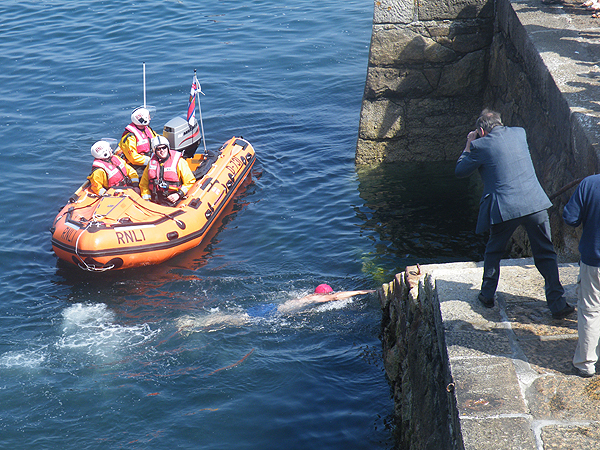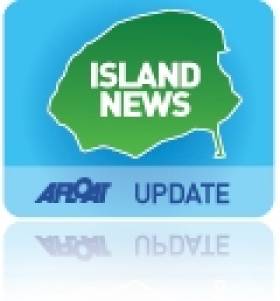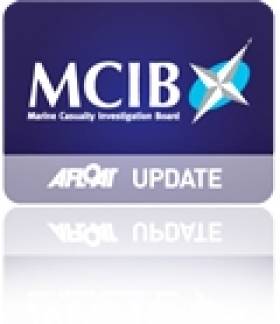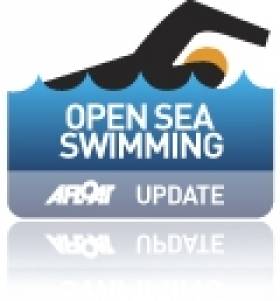Displaying items by tag: coliemore harbour
#Ex007inDalkey- Pierce Brosnan, the Irish born actor and former 007 James Bond, caused quite a stir on the first day of March in Dalkey. The actor was on a location shoot and was understood to be making a TV advert campaign with scenes from the south-side suburb and at Coliemore Harbour, writes Jehan Ashmore.
Dalkey which is well known for its famous string of celebrities, had greeted the Navan born actor's presence with a distinct buzz in the Spring air, as the cameras rolled at the scenic coastal location facing out to Dalkey Island.
For the shoot Brosnan stood at the public viewing area above the harbour, where there is a binocular-scope which is dedicated in the memory of the life and work of the late Dr. John de Courcy Ireland.The former Dalkey resident, was a maritime historian, teacher and linguist and who is widely regarded as the 'father' of Maritime Ireland.
Brosnan played Bond between 1995-2004 during which four films were produced. It was in his second outing as Bond in 'Tomorrow Never Dies' that a Royal Navy frigate, fictitiously named HMS Devonshire made a brief appearance. The frigate was sunk in the South China Sea by a stealth ship, instigated by the evil media mogul magnate Elliot Carver, head of the Carver Media Group Network (CMGN).
By an uncanny coincidence, only a couple of hours before the shoot at Coliemore Harbour took place, HMS Richmond (F239) a sister of the frigate that played the role in the film (in real life HMS Somerset), had sailed past The Muglins lighthouse off Dalkey Island. As previously reported, HMS Richmond, a Duke class frigate was bound for Dublin Port for a courtesy call over the weekend.

007 signs autographs for Dalkey fans. Photo: Gail Bonass
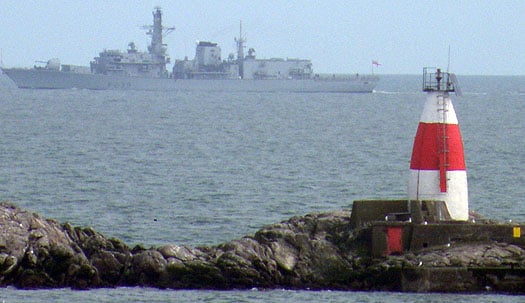
HMS Richmond passes the Muglins on Dublin Bay. Photo: Jehan Ashmore
Brosnan's visit to Dalkey was certainly a surprise for locals and tourists alike and will no doubt assist in boosting visitor numbers. By another coincidence on the same day, the town's Heritage Centre on Castle Street, the main street of the former port town for Dublin during medieval times, reopened after completion of a major upgrade of the visitor centre.
Unlike the former Bond's notable presence, HMS Richmond slipped quietly out of Dublin Bay today. Having said that, could there be a connection!....According to yesterday's Irish Times –The Social Network column, among his next film projects is 'November Man', an espionage movie. He quoted "...the stage is big enough for Daniel and myself".
Consultants to Carry Out Survey of Coliemore Harbour
#COLIEMORE HARBOUR FERRY – Asides the controversial issue of the granting for an exploratory oil well drill license off Dalkey, local residents group have also stepped up a campaign since the summer to restore the island ferry which has not been operating in recent years, reports Jehan Ashmore.
As previously reported on Afloat.ie, Dun Laoghaire-Rathdown County Council's recent unveiling of a consultant's report of the proposed PART 8 Scheme to upgrade Dalkey Island harbour, also sees the same consultants appointed to carry out a separate survey of Coliemore Harbour, the traditional mainland embarkation point of the ferry run by generations of local families.
The consultants Malachy Walsh & Partners are to carry out a structural survey on the condition of the small stone cut harbour completed in 1868, which aswell as a tourist attraction is an amenity throughout the summer for anglers, divers and kayakers alike.
DLRCC which owns the harbour, have deemed the piers unsafe and claim concerns over public safety issues for those accessing the harbour when commercial boats were in operation. It is expected that DLRCC are to receive the conclusions of the report though not until February or March, this is to enable the consultants to monitor winter weather impacts on the harbour.
The council have claimed that repair costs could be prohibitive, possibly running into millions and it is understood that such expenditure were not factored into council's Capital Programme 2012-2016. As previously alluded, the PART 8 scheme exclusively deals with Dalkey Island alone where there also plans to restore the Martello Tower and Gun Battery, though not St. Begnet's Church which is the responsibility of the OPW.
The ferry restoration group, has also called for the short five-minute ferry ride to the 22-acre island be reinstated by a licensed operator. The licensing is under the remit of the Marine Survey Office at the Department of Transport and a future ferry service would require an open tendering process.
It has been feared by locals that the demise of a boat service arising from Coliemore's closure to ferry services, could lead to a temporary or longer term service running from Dun Laoghaire.
As previously reported on Afloat.ie a new cruiseliner tender dock facility was installed earlier this year as part of the Dun Laoghaire Harbour Company masterplan, where the facility would also be used for boat tours of Dublin Bay and to Dalkey Island.
It has been suggested that should such a service run, that a RIB based craft would be likely used on the longer exposed crossing to the island and taking up to 25 minutes. The consequences of an enhanced ferry operation and its potential impacts on the island were discussed as part of last month's inaugural Dalkey Island Forum.
Dalkey Island Forum
#DALKEY ISLAND – St. Patrick's Church of Ireland, Dalkey will be the venue for the Dalkey Island Forum, on 24 November between 9:30am - 1:30pm.
The forum will comprise of a panel of leading experts with presentations providing an overview of the unique archaeology, history and architectural features of this special island on the coast off south Co. Dublin.
The forum will also consider issues around access and management of the Island in the context of proposals by Dun Laoghaire Rathdown Council to 'improve' the landing place, while at the same time opposing moves to restore the historic ferry link from Coliemore Harbour.
Below is a list of speakers and topics arranged for the forum which is sponsored by Dalkey Civic Trust.
Dr Neill Brady, The Archaeological Diving Company: 'The Archaeology of Dalkey Island'
Dr Edel Bhreathnach, Michael O'Cleirigh Institute UCD: 'St Begnet and Dalkey's early Christian heritage'
Jason Bolton, Conservation Consultant: 'Conservation of the architectural heritage of the Dalkey Islands'
Darina Tully, Maritime Archaeologist: 'Dalkey as a Maritime Cultural Landscape'
Admission is €12 at the door or €10 per person (pre-registered if booked online click HERE) - to include tea, coffee and refreshments. For further details contact: Reg McCabe, Dalkey Civic Trust on 086 242 0962
Save Our Seafront Host Public Meeting in Dun Laoghaire Tonight
#DUN LAOGHAIRE NEWS - Save Our Seafront will hold a public meeting this evening Thursday 4 October at The Kingston Hotel in Dun Laoghaire to discuss a number of issues such as the redevelopment of the harbour baths, the demolition of Blackrock Baths and repairs at Coliemore Harbour.
The South Dublin campaign group - featuring People Before Profit Alliance TD Richard Boyd Barrett and Dun Laoghaire-Rathdown Councillor Melisa Halpin - has circulated a newsletter outlining its position on these concerns.
Among its claims is that Dun Laoghaire-Rathdown County Council (DLRCC) wants to abandon its previous commitments to provide a public swimming pool on the site of the historic Victorian sea baths, opting instead for a €1.5 million 'Badeschiff' or floating pool in the harbour with no permanent construction.
The group also describes as a "disgrace" the abandonment of the Blackrock Baths site, which faces imminent demolition due to public health and safety concerns, and takes issue with DLRCC councillors' apparent declaration that Coliemore Harbour in Dalkey - the main departure point for boat trips to Dalkey Island - is unsafe for passenger boats.
The public meeting under the title 'What Is Happening To Our Seafront?' takes place tonight at 8pm in The Kingston Hotel on Haddington Terrace.
Epilepsy, Lack of Lifejacket Big Factors in Death of Dublin Boatman - MCIB
#MCIB - The death by drowning of a South Dublin boatman may have been avoided had he been wearing a lifejacket or buoyancy aid, according to investigators.
The report by the Marine Casualty Investigation Board (MCIB) into the death of Aidan Fennell off Dalkey Island on 12 October 2010 found that an epileptic episode could have caused him to fall overboard from his rowboat and become disorientated once in the water.
Fennell, 43, was considered a competent boatman and a strong swimmer used to cold water, though was prone to seizures where he could not control his muscles and lost sense with reality, on occasion becoming unconscious.
On the afternoon of 12 October last year Fennell had launched his boat from Coliemore Harbour in fair conditions, intending to ferry a German family to Dalkey Island. When they pulled out of the trip, Fennell decided to row to the island on his own, with no flotation devices on board.
He was last seen by friend Kevin O'Farrell at 2.50pm. Around half an hour later, O'Farrell became concerned as to Fennell's whereabouts when he had been out of sight for some time.
After notifying the Irish Coast Guard, the Dun Laoghaire lifeboat and coastguard helicopter Rescue 116 were dispatched to search the area. Fennell's boat was located before 4pm washed on the rocks at the southeast end of Dalkey Island, and his body was found in the water close by some 10 minutes later.
No injuries were found on Fennell's body, suggesting that he went into the water before his boat washed up on the rocks.
The report concluded that if he had fallen overboard in normal conditions "it is considered likely that he could have swum to his boat, or clung on to the oars.
"However, if he had suffered an epileptic episode... he would have had great difficulty in staying afloat, in particular without having the buoyancy assistance of a life jacket."
The full report is available to download as a PDF from the MCIB website HERE.
Tanker and Lifeboats Conduct Emergency Exercises off Dalkey Island
Crew kitted in similarly bright orange coloured sea safety-survival suits entered the lifeboat before it plunged into the water. The activity was observed through the binocular-scope which overlooks Coliemore Harbour with excellent views across the sound to Dalkey Island, Dublin Bay and Howth Peninsula.
The binocular-scope does not require payment to operate and was unveiled in 2008 in memory of local resident the late Dr. John de Courcy Ireland, the 'father' of maritime Ireland (to read more click HERE). He was for 26 years a honorary secretary of the local RNLI station in Dun Laoghaire and a staunch campaigner of Irish maritime affairs.
Each Monday a routine lifeboat practice is conducted by the 47ft Trent class ALB (all-weather lifeboat) RNLB Anna Livia (info and PHOTO). Last night's drill also involved the new D-class ILB (inshore lifeboat) RNLB Réalt na Mara which was named earlier this year by Kathy Kenny, wife of RTE presenter Pat Kenny.
Under the cover of darkness the crew of the ILB Realt na Mara simulated an 'injured casualty' on the island where the casualty was prepared to be taken off by stretcher from the island's small harbour. From there the casualty was transferred to the larger RNLB Anna Livia which lay offshore. During the exercise, powerful searchlight beams from the ALB provided essential light to assist in the transfer operation.
Asides the lifeboats, there is plenty of wildlife to observe on the rocky outcrops at Maiden Rock, Clare Rock and Lamb Island, which forms the second largest island after the main island of 22-acres, where a resident herd of goats have been part of the local community for over 200 years.
As for the South Korean built Cumbrian Fisher, she too has close connections with these waters as she was named in Dublin Port in 2005. She is a frequent caller to Dublin bringing bulk liquid products from the oil refinery in Milford Haven, Pembrokeshire which is a major supplier, serving the demands of the capital.
Dublin Port has two oil jetties which cater for four tankers, where bitumen, chemicals, liquid petroleum gases, molasses and oil are handled on a 41-hectare zone with storage for 330,000 product tonnes to include 6,000 tonnes of LPG. In addition aviation fuel is frequently delivered to the terminal to satisfy the constant demand for aircraft using Dublin Airport.
Cumbrian Fisher alongside her sister Clyde Fisher where built for James Fisher & Sons and in recent years they have tended to take anchorage off Dalkey Island and off the Nose of Howth. In comparison the vast majority of vessels anchor in Dublin Bay which is divided into quadrants for the purposes of anchorage allocation.
Before the completion of the South Wall in Dublin Port, which considerably improved safer access of vessels entering the River Liffey, it was the relative deeper and sheltered waters of Dalkey Sound which were used instead as Dalkey acted as the principle port for Dublin between 14-17th centuries.
Vessels would convey cargoes which were taken to and fro by lighter to the coast where it was carried by horse and cart to nearby Dalkey before onward travel across the exposed plains to Dublin City.
To learn more about Dalkey's medieval maritime heritage with its relationship with the capital of Dublin in addition the use of Dalkey Quarry in the construction of (Kingstown) Dun Laoghaire Harbour, visit the Dalkey Castle & Heritage Centre. To read more go to www.dalkeycastle.com in addition to further information about Dalkey including the local community council newsletters click HERE.
- Dublin Bay
- Dublin Airport
- Dublin Bay News
- Commissioners of Irish Lights
- Irish Lights
- coliemore harbour
- Pembrokeshire
- Dalkey Island
- Port of Dublin
- River Liffey
- Ports and Shipping News
- The Muglins
- Coastal Notes
- Howth Peninsula
- Pat Kenny
- Dalkey Sound
- Lighthouse news
- Irish Lighthouses
- Cumbrian Fisher
- Jas Fisher & Sons
- Clyde Fisher
- Milford Haven Oil Refinery
- Dalkey Castle & Heritage Centre
- Dr. Ireland
- Dr. John de Courcy Ireland
- Irish maritime historian
- Kingstown Harbour
- Kathy Kenny
- RTE presenter Pat Kenny
- South Wall Dublin Port
- Medieval Dalkey
- Dalkey Quarry
- Aviation fuel
- Dalkey Tidy Towns Committee
- Nose of Howth
- Dublin Port Oil Jetty Terminal
- Dalkey Community Council
- Dalkey Island Goats
The 162 gross tonnes tug had served a career of nearly three decades in Dublin Port, after entering service in 1972. Prior to working in Irish waters the 100ft tug spent the previous decade operating in the UK as Appelsider for Lawson-Batey Tugs Ltd who chartered her to Tyne Tugs Ltd. For historical record and photos click HERE.
In 1998 the Dublin Port Company disposed of the Coliemore alongside her running mate Clontarf (1963/178grt) the former Cluain Tarbh, also built from the same Yorkshire shipyard on the banks of the River Humber.
Initially they were towed to Liverpool but they later appeared at Cork Dockyard in 1999. The Clontarf remained there for a year until she was sold to Barcazas Dominicia SA, Santo Domingo in the Dominican Republic. For photo of the tug in far distant waters click HERE. It was intended Coliemore would follow her Caribbean counterpart but her sale fell-through.
The vessel's ownership eventually transferred to Cork Dockyard where her scrap value will pay for her long-term berthing fees. The tug recently made her final short journey under tow from her berth at the former Verolme Cork Dockyard (VCD) to the facilities slipway where work to break-up the vessel began.
Coliemore and her fleet-mates were given the traditional naming theme of Dublin Bay coastal suburbs spelt in Irish. The naming policy was used by the Dublin Ports & Docks Board (DP&DB) which operated the fleet remained until transferred to the Dublin Port Company established in 1997.
The last tugs to carry the traditional names, Ben Eadar (Howth), Cluain Tarbh (Clontarf) and Deilginis (Dalkey) are now up laid-up awaiting to be sold, to read more click HERE.
Between the 14-16th centuries Dalkey Sound became increasingly important as larger vessels with deeper drafts could no longer enter the port in Dublin due to the dangers of constantly shifting sandbanks and swallow channels in Dublin Bay.
The nearest alternative was for vessels to anchor off Dalkey Island and in the relative shelter of Dalkey Sound where cargoes for the capital where transferred to and fro by lighters to the coastline along Dalkey at Coliemore, which became the principle port for Dublin. Some of the cargo was stored temporally in the medieval castles in Dalkey, otherwise it was directly transported by horse and cart across the plateau to the city.
It was not until the 17th century that the issue of accessing the port of Dublin was resolved, with the completion of the harbour walls that enabled shipping to return on a frequent basis. Captain Bligh of the 'Mutiny on the Bounty' completed mapping Dublin Bay in 1803 which became the most accurate chart at the time and this aided to the safety of mariners.
The fortunes of Dublin's shipping trade increased due to the combination of an easier and safer navigational channel and deeper depths along the quaysides. This led to the eventual demise of shipping using Dalkey. The present-day harbour structure at Coliemore Harbour was constructed in 1868 and is home to a humble fleet of recreational boats and a passenger-ferry service to the island.
- Howth
- Dublin Bay
- Dublin Port
- Clontarf
- Dublin Port Company
- dalkey
- coliemore harbour
- Dalkey Island
- Port of Dublin
- Ports and Shipping News
- Cork Harbour News
- Verolme Cork Dockyard
- VCD
- Dalkey Sound
- Mutiny on the Bounty
- Dublin Port Tugs
- Deilginis
- Captain Bligh
- Dublin port tugs for sale
- Coliemore
- Coliemore tug
- Cork Dockyard
- Cork Dockyard Rushbrooke
- Cluain Tarbh tug
- Ben Eadar tug
- Deilginis tug
- Richard Dunston (Hessle) Yorkshire
- River Humber
- Dublin Ports & Docks Board
- DP & DB
- Cork Dockyard shiprepairers
- Irish shipbuilding
Dalkey Island Swim Raises funds for African hospital
This year's charity swim across the sound from Dalkey Island to Coliemore Harbour took place on Sunday 15 August writes Jehan Ashmore.
The event raised a total of €5,000 with the proceeds benefitting the Kisiizi Hospital in south-western Uganda. The padraetric hospital is planning to install a new theatre.
During glorious summer sunshine, around twenty participants swam the sound with RIB-boat tenders from the Royal St. George Yacht Club (RSGYC) in attendence and also keeping a viligant eye was Dun Laoghaire's new RNLI inshore lifeboat, Realt Na Mara (D-731), a type IBI-1 craft. The event is held every August on a Sunday with swimmers paying a pre-registration fee as part of the fund-raising effort.
For several years, Kisiizi hospital has received the support of the organisers of the charity swim and assistance from St. Pauls Church, Glenageary. For further information on the fundraising swim; contact Peter Craven (01) 2855543
